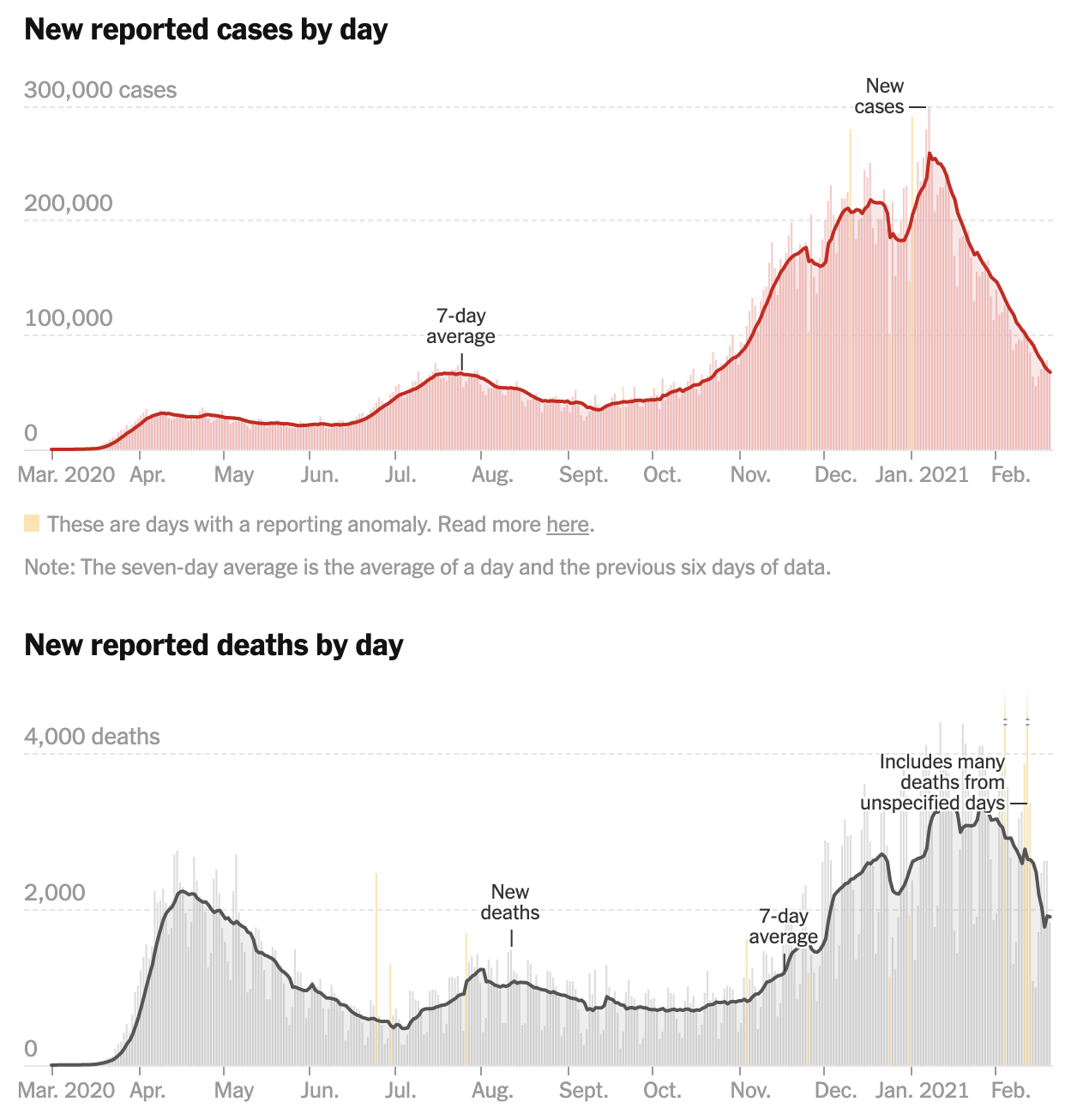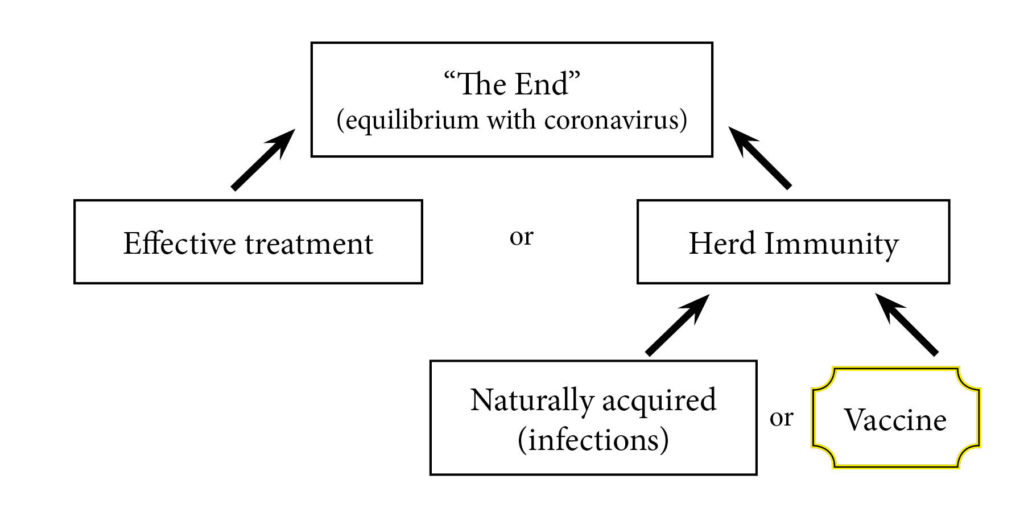A season of hope

Source: New York Times coronavirus tracker, February 21, 2021 link
Season of Hope
As my parish begins the season of Lent in preparation for Easter, we celebrate a nine-day “Novena of Grace.” This year the theme is Hope, one of the three theological virtues (along with faith and love/charity). Naturally, much of the reflection about hope has touched on the SARS-CoV-2 coronavirus pandemic.
I wanted to stand up and shout something, but decided to write a blog post instead. I wanted to say, hope about the end of the pandemic isn’t mystical or eschatological. Unlike hope for the Kingdom of God, or the afterlife, or world peace, you don’t have to be a Christian or a person with any kind of religious faith to be hopeful about COVID. The signs are real, and obvious. The end of the pandemic is in sight.
Negativity reigns
We are programmed, it seems, to focus on the negative. Some staggering percentage of what we call “news” is speculation about what might happen (skim the headlines to prove this). And that speculation is almost uniformly negative or even alarmist. Panic sells, because humans respond more strongly to fear than to hope or joy.
A year ago, the negativity, the caution, the fear was justified. There was so much we didn’t know about this new virus. And we had a terrible year ahead. Back in March 2020, a team of British scholars at Imperial College London predicted, if we took no action, 2.2 million Americans would die of COVID-19. This sensational report prompted some of the first concrete effort at non-pharmaceutical interventions (NPIs, including social distancing) in the US. The report also prompted a backlash by COVID skeptics, who claimed it was sensationalized, wrong, and motivated by a left-wing alarmism intended to restrict personal freedom.
Guess what? By the time you read this less than one year after the Imperial College report, 500,000 Americans will have died of COVID-19. The scientists were mostly right. Wait, you say, they predicted two million deaths, not half a million. Correction, I say: Their model predicted two million deaths if we didn’t make any changes to our behavior. I think we can all agree that whether you went along with it or not, a lot of changes to behavior certainly did happen. Yet still we’ve had this tremendous toll of deaths.
So why am I now so hopeful? Why am I anticipating one of the most joyful Easters in memory?
Because of the vaccines.
Litany
Yes, those vaccines that some people think are a plot to kill them or tag them or alter their DNA. The vaccines that you can’t get because they’re not being manufactured fast enough. The vaccines that are sometimes being given to people who lied or skipped the queue. The vaccines that are going to make a lot of money for some pharmaceutical companies. The vaccines that the rich world will get before the poor world. The vaccines that may have some distant connection to an aborted baby. The vaccines that don’t stop every single infection. The vaccines that might not work as well against some variants of the virus. The vaccines that give some people headaches, muscle pain, or fever. The vaccines that require expensive refrigeration, and two doses instead of one.
Should I continue? How many bad things can I say about one of the most astounding, most impressive, and dare I say, miraculous technical achievements in human history?
I cannot believe how totally we are underselling the creation, testing, and manufacture of not one, not two, but multiple different highly effective, very safe vaccines against a brand-new virus in less than a year. Yes, there are uncertainties. Yes, there are imperfections. Yes, there are practical challenges. But let’s not lose the main thread here.
Vaccination will end the pandemic.
Endgame
Last April, I wrote a series of blog posts about the endgame: how would the pandemic end? Let’s revisit the figure I created for the first post:

I stand by everything I said at that time. SARS-CoV-2 coronavirus is not going away. It will be with us for the foreseeable future (years, decades). The “end” is not eradication, but an equilibrium. A few thousand COVID deaths per year (in the US) going forward would be a reasonable expectation. As I predicted, COVID treatments have gotten more effective but there is not, and will not be, a cure. The only path to relaxing our non-pharmaceutical interventions (social distancing, etc.) without significant loss of life is herd immunity.
And that’s where we are rapidly headed right now.
Without a vaccine, the coronavirus will eventually infect somewhere from about 70 to 90% of all people in a community, at which point the lack of susceptible hosts (without immunity) will break the chain of transmission. The only alternative to this natural herd immunity is the same number of people immunized by a vaccine. Confronted by either or a combination of these two processes, the virus will diminish in prevalence to a low level, or it will have to mutate a lot.
Last April, I was deeply doubtful about the prospect of having a safe, effective vaccine in time to make a meaningful difference in the relentless development of herd immunity in the US by natural infection. You may remember the many discussions/arguments based on the scantest data, as people tried to prove or disprove that vast numbers of asymptomatic and undiagnosed COVID infections were hurtling us toward herd immunity without significant consequences. Based on the explosion of cases we saw in later waves and most of all in December and January, clearly that was a fantasy. And yet, if a vaccine took years to develop, we could suffer under crippling restrictions for far too long. I even wondered, what if we never get a safe and effective vaccine? There were no guarantees. Look at HIV, the virus that causes AIDS. Decades of effort, no vaccine. What if COVID turned out like that? Better to let the virus run its course with a modest containment effort to protect the health care system, and get to herd immunity sooner rather than later
Praise God, and praise our scientific-medical-industrial establishment, my doubts were misplaced. The vaccines are here. We can get immunity without getting sick.
How far have we come?
There are 328 million Americans.
- More than 28 million have had a formal COVID case diagnosis (Johns Hopkins)
- More than 43 million have received one or more doses of vaccine (CDC)
- The CDC estimates that about 1 in 4.6 COVID infections have been reported (CDC). That means maybe an additional 100 million American cases not counted formally.
Very roughly, that’s 171 million out of 328 million, over 50%, of Americans have some degree of immunity to the coronavirus. As more and more people get both doses of the vaccines, that degree of protection will rise. Currently (February 21, 2021), an average of 1.5 million doses of vaccine are going into American arms every day (NYT). That number is expected to increase.
And so, my message of hope. Not Christian hope (although that’s always a good and true thing). Pragmatic, science-based hope. Thanks to vaccination, the terrible peaks of cases, hospitalizations, and deaths that we recently experienced should be the last such peaks. I predict that the worst of the pandemic is over in the US. Be not afraid. Hang in there with the masks and the distancing a bit longer. Get vaccinated as soon as it’s your turn. Our national day of resurrection is coming.
Additional Notes:
What does 95% COVID-19 vaccine efficacy really mean? LINK
“The public messaging about vaccines {emphasizes} uncertainty and potential future bad news.” LINK
Amy Rogers, MD, PhD, is a Harvard-educated scientist, novelist, journalist, and educator. Learn more about Amy’s science thriller novels, or download a free ebook on the scientific backstory of SARS-CoV-2 and emerging infections, at AmyRogers.com.


